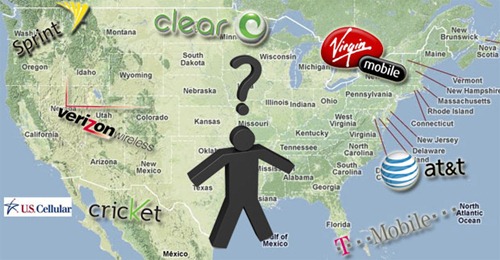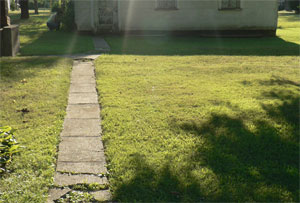This is a 4-part lesson on "How To Pick The Best Mobile Broadband Provider". Previously we covered, how to pick a mobile broadband plan and how to pick a provider based on mobile broadband speed. In this section, we cover finding the best mobile broadband coverage for your needs.
Mobile broadband coverage is the engine of high speed internet on the go. Without it, your going nowhere (online) fast. Instead, you’ll be creeping along on what’ll feel like dialup speeds.
Pictures load at the speed YouTube videos normally do.
Like paint drying on the wall, your downloads will have ETA’s of in hours…possibly even days for just one TV episode.
That’s a terrible way to live especially if you’re paying for broadband speeds.
That’s why knowing exactly where you’ll have the best mobile broadband coverage is so critical.
Before we get into how to actually check for the 3G or 4G coverage in your area, let’s make a quick but necessary pit stop to understand just what the heck it is in the first place.
What Exactly is Mobile Broadband Coverage Anyway?
Mobile broadband coverage is any area you can receive speeds faster than 768 Kbps via a mobile device.
Since the FCC defines broadband as speeds faster than 768 Kbps.
Therefore, mobile broadband coverage is any area you can receive speeds faster than 768 Kbps via a mobile device.
For the most part, you’ve got 2 main tiers right now:
1. 3G Mobile Broadband Coverage
2. 4G Mobile Broadband Coverage
While 3G breaks down into the CDMA camp (EVDO Rev. 0, EVDO Rev. A) vs. the GSM camp (HSPA, HSPA+) and 4G breaks down into WiMAX (already launched) vs. LTE (launching in 2010), the important take-away is this:
Average 3G speeds range from 600 Kbps to 1.4 Mbps while average 4G speeds range from 3 Mbps to 6 Mbps. That’s anywhere from 3 to 6 times as fast.
While 3G speeds actually have the potential to get as fast as 21 Mbps, 4G tests have shown speeds up to 100 Mbps.
Are these coming anytime soon?
While T-Mobile’s testing it out 3G HSPA+ tech that gives 21 Mbps in multiple markets, don’t expect nationwide mobile broadband coverage for at least 1 – 2 years (from any carrier).
Likewise, don’t expect 100 Mbps speed from any carrier (LTE or WiMAX based) for 2 or more years to come.
That’s gravy and all, but how does it affect the price of rice in China?
Here’s how.
Knowing what mobile broadband coverage is gives you a baseline to judge whether the service you are getting or thinking about getting is worth your cash.
Also, having a crisp picture of what mobile broadband speeds should be, let’s you know whether you’re being ripped off.
While you’ll get service pretty much anywhere you can get a cell phone signal, high speed service may or may not be there. Lastly, depending on the carrier, mobile broadband speeds may be available nationwide or only in select areas.
So How Do I Find The Best Mobile Broadband Coverage?
It’s not an easy road.
While I can provide you the tools, I cannot walk the journey for you. I can only best prepare you.
To do so, you’ll find a table below summing up the need-to-know info on each carrier regarding their mobile broadband coverage.
Its not expected that you’re going to look through each of these. It’ll be much quicker if you’ve already narrowed down your options based on how to pick a mobile broadband plan and how to pick a provider based on mobile broadband speed.
Afterward, we’ll look in your backyard and check the 3G or 4G coverage of the few providers you’re trying to decide on.
Adapted from the Wireless Broadband Comparison
– Adapted from the 2009 Prepaid Mobile Broadband Comparison
As you’ve probably noticed, most prepaid and rental companies inherit features of their ‘parent’ networks. It’s to be expected since building a mobile broadband network from scratch is quite the costly investment. For many, it just makes a whole lot more sense to ‘rent’ or ‘lease’ the network and repackage it in a profitable yet mutually beneficial way for everyone.
– Adapted from the 2009 Mobile Broadband Rental Comparison
Time To Look In Your Backyard
Now that you’ve got a general view, it’s time to get into the nitty gritty make or break details.
For each carrier (or just the ones you’re interested in), we’ll check what mobile broadband coverage is like in your area. You’ll be plugging in your address a couple times in multiple windows. As such, you may want to keep it handy in notepad or Microsoft Word for some copy and pasting.
To keep things simple, here’s a few short steps to keep things organized:
1. Click on any provider’s logo to begin. Be sure to disable any pop-up blockers since each link will open in a new page or tab (depending on your browser).
2. If you click on a provider such as Virgin Mobile but see Sprint’s coverage map pop up, it’s not because you clicked the wrong link. Since Virgin uses Sprint’s network, you’ll need to use Sprint’s map to find out what your coverage will be. Also, if you click and absolutely nothing happens, it’s because no coverage map is available for that provider.
3. Plug in your address and see what your coverage is like. Afterwards, finish reading the rest of this page for what comes next.
4. (If necessary) Make sure the coverage map is on the ‘broadband’ or 3G tab instead of the default ‘voice’ tab. Most providers are cell phone companies and show calling areas that may not reflect mobile broadband coverage.
How To Double & Triple Check Your Coverage
Not too trusting of what the mobile broadband providers say?
Can’t say I blame you.
It wouldn’t be the first time we’ve gotten a complaint from one a reader who’s been stuck without service despite the coverage maps saying otherwise. In the hopes of fixing that problem, there’s GotReception.com that shows user reported signal strength by major providers. Plug in your address to get a feel for what things might be like in your area.
Now it may not even be enough to know where the carriers themselves claim to have coverage. To dot the i’s and cross the t’s, there’s one more tool you can use.
DeadCellZones.com allows you plug in your address and see if anyone has reported dead zones for your carrier (or potential carrier). Quite the handy feature. Since it’s user generated content, it’s hard to verify but if it gets anywhere as massive as, say, Wikipedia, it’ll only become a lot more useful in times to come.
I Know The Provider With The Right Plan, Speed & Coverage I Want
What Next?
Now that you’ve got a clear grasp on how to pick a mobile broadband plan, how to pick a provider based on mobile broadband speed, and how to find the best mobile broadband coverage for your needs, there’s 1 final piece to the Da Vinci Code of mobile broadband.
If you feel you don’t need it, you can start getting connected now:
| I Know What I Want. Lemme Get Some Mobile Broadband | Not sure if I know enough yet. Lemme keep reading |

|
Next up: |





![virgin-mobile-broadband[6] virgin-mobile-broadband[6]](wp-content/uploads/2010/12/virgin-mobile-broadband6.jpg)
![eventradiorentals[6] eventradiorentals[6]](wp-content/uploads/2010/12/eventradiorentals6.jpg)